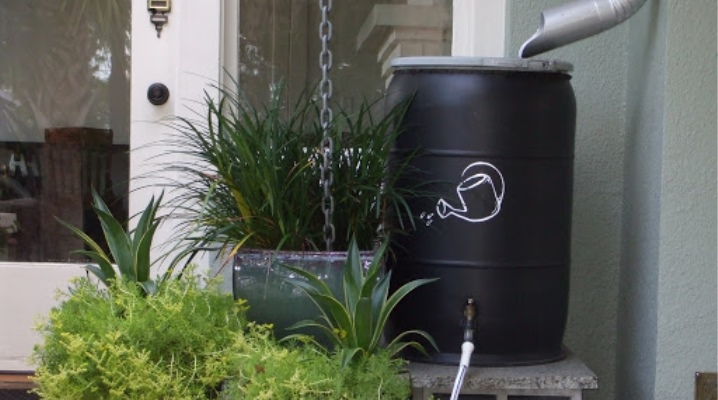Features of rainwater barrels

The useful features of rainwater barrels do not need advertising - everyone who worked in a summer cottage without a regular water supply can quickly and easily list them. Once delivered, wooden, metal or plastic barrels are filled with natural sediments. To obtain water, you do not need to pump it from a well, pay for water and electricity consumption meters. The efforts made and the money spent are more than compensated.



Description and purpose
Reservoir for collecting rainwater is a general definition of any container of cylindrical or square shape located in a garden or vegetable garden to collect natural precipitation. The double benefit is saving some usable rainwater for later irrigation and saving money on water bills. The description often overlooks the lack of physical effort applied in other ways, and the possibility of using containers for decorative purposes.


The equipment and placement of such tanks on their own land ownership is carried out to achieve several goals:
-
the use of soft water of natural origin for irrigation;
-
the possibility of preserving the roots of cultivated plants (using warm water heated in the sun);
-
no need to use filters (if sprinkler systems are not installed);
-
you can take rain water from a clean barrel, and save on detergents;
-
in the absence of regular water supply, it can be used for domestic needs - cleaning floors, garden paths and benches in the recreation area.
Placing a barrel under a downpipe or roof slope is the most productive method of harvesting a valuable resource. However, the material from which the roof is made can degrade the quality of the water.


Therefore, they are placed around the perimeter of the garden in unclaimed space - in areas where plants are not planted or in open places (for household and decorative purposes)
What are they?
The tank is an integral attribute of the landscape in the country, the main reservoir for storing water supplies. Depending on the scale of agricultural activity, it can have a capacity from 5 tens of liters to several tons. From huge metal, painted or stainless steel, to small, inert, food grade plastic - all this variety falls under the definition of a tank.


A tank with a tap can be connected to a filtration system, but this feature also depends on the used irrigation system or other needs for which water saving is organized. There are other ways to differentiate between species.
-
Plastic, metal, wood or ceramic, enameled - the variety of materials of manufacture depends on the capabilities and preferences of the owners. But each of them requires careful attention and subtleties of care - timely cleaning, painting, coating with compounds for long-term operation. Wood is less resistant, but more durable of other materials can be painted under a tree.
-
The color of the tank is not so much for decorative as for utilitarian purposes. So, black is appropriate on the roof of the shower stall - the water in it heats up quickly, if the surface is reflective, the coolness remains. Neither hot nor cold water is suitable for irrigation, but cool water is useful in extreme heat.Although dark barrels are also useful - prolonged heating of water contributes to its disinfection.
-
The most common placement is where water drains off the roof. But there is a tendency to use beautiful tanks for landscaping: garden barrels can be painted, made from them vintage garden sculptures or decorative stylish structures.
-
According to the degree of equipment, barrels can be with simple or hermetically sealed lids, with taps for water intake (factory and homemade), with filters - for systemic irrigation, nets - to ensure the safety of small pets and small children.


The selectivity of the material and the variety of capacity does not matter if the tank is closed with a lid to prevent clogging of a valuable resource and is equipped with a valve for its selection. The choice depends on existing needs, personal preferences or the available reservoirs at your disposal. When buying, the price category matters, but sometimes it's better to pay more and save yourself the hassle of refurbishing.


How to overflow?
The need for a large amount of water for irrigation forces the owners to start several barrels and place them in a row under the drain. Craftsmen have developed a convenient method without the use of tie-ins and fittings. The connection can be made cascading by connecting the barrels with plastic pipes, placing them at different heights. If you combine them into a common system, you can achieve the simultaneous filling of all at once. In order not to bother with making holes in the lids, there is an excellent way out - a mesh into which it is easy to pass a mobile corrugated plastic tube, and at the same time to protect the small inhabitants of the summer cottage from possible danger.


A barrel for collecting rainwater is a broad concept, which means reservoirs of variable shape, capacity, material of manufacture and color. The demand for summer cottage equipment among gardeners and truck farmers has given birth to numerous proposals from manufacturers - of varying degrees of equipment, with functional devices. But the use of reservoirs left over from other processes or simply thrown away as unnecessary and adapted for utilitarian purposes still prevails in equipping large and small land holdings.


Watch a video on the topic.













The comment was sent successfully.